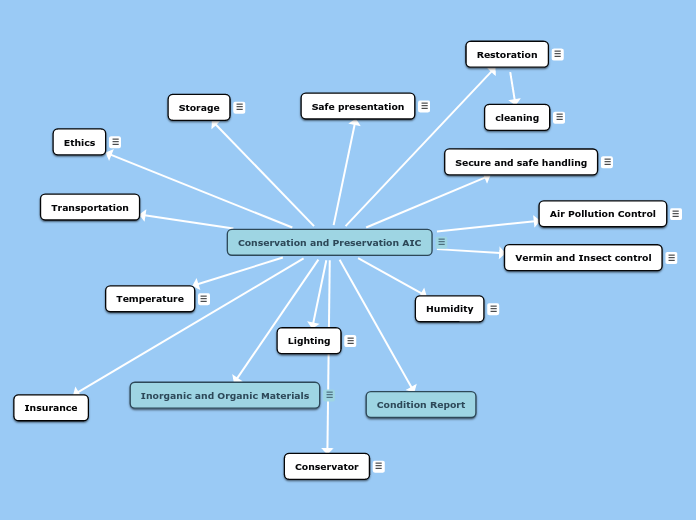Conservation and Preservation AIC
Art conservation is about the preservation of art works.
All art works begin to deteriorate from the moment they are produced – from direct sunlight, heat, dampness, insects and rough handling.
There are standard techniques for preserving and extending the life of art works through control of lighting, temperature, humidity, vermin control, storage, safe presentation to the public, security and safe handling and transportation.
Modern conservation is directed towards producing a stable, favourable situation for the display and storage of art works and maintaining regular inspection and diagnostic procedures to combat deterioration.
Air Pollution Control
Pollutants such as sulphur dioxide and nitrogen oxides when combines with water vapour create acids which attack both organic and even inorganic materials such as stone and marble. The most dangerous is sulphuric acid – this attacks a range of materials and causes paper and textiles to rot and leather to powder and decay.
Dust has very sharp edges when viewed microscopically, this can be an abrasive to the surface of artworks as well as disfiguring the work.
Places located near the sea can have salt present in the air and this can damage both organic and inorganic materials.
Members of the general public are identified by the NGA as one of the greatest causes of pollution of art.
An examination of the dust vacuumed from an exhibition found parts of human skin, hair, oil particles and thread from clothing and dirt from shoes.
Measures to reduce the exposure of works to pollution include:
• Air filtration systems
• Display cases to house artworks in when on display
• Regular cleaning of the premises
• Wearing thin white cotton gloves when handling artworks
Ethics
Ethical issues come into play for conservators when artists actually create work with the intention that the work deteriorates naturally over time – do you rust proof a public sculpture to preserve the cultural asset when the artist intended the sculpture to rust naturally?
Restoration
Conservation also includes the restoration and repair of art works that are damaged.
An important aspect of conservation is the ongoing inspection and analysis of artworks to determine levels of damage or disintegration. Decisions are then made about remedial action to slow down the rate of disintegration OR to restore OR to repair damaged parts of the work.
Public galleries spend significant resources in maintaining inspection processes to determine the state of disintegration of the works in their collections.
There are private companies that act as art conservators and assess the state of an artwork for gallery or private owners.
Inspection procedures range from:
• simple visual inspection
• X-ray, infrared, and other radiation examinations
• Complex chemical analysis
•
The rates and processes of disintegration in some artworks are not fully known, nor are the methods of remedial repair.
Once the level of disintegration or damage is ascertained the conservator makes a decision about repair or restoration.
Certain treatments are applied to a work to slow its disintegration.
This may include:
• Fungicidal treatment to remove mould or the presence of insects in wood.
• Electrolytical treatments applied to stop the corrosion of metals.This includes processes to repair the structure of a work which is not necessarily visible
to the eye of the viewer.
For example,
Repairing the wooden supports of a canvas
Relining an old canvas by gluing a new canvas under the original
Filling a decaying wooden sculpture internally with a plastic filler to provide internal strength
Replacing mounts and backing surfaces of a work on paper with acid-free boards
Repair and regild the frame which surrounds the work
cleaning
Cleaning a work is the simplest form of restoration.
This includes:
Removing grime and pollution from paintings, sculptures and decorative pieces.
Using various cleaning agents depending on the nature of the material.
For example,
• Works on paper may be cleaned through bleaching and extremely careful washing to remove
acid attack and staining.
• Human saliva is sometimes used in cleaning paintings.
Conservator
o Where are they employed?
o What type of specialities exist in this field?
o Who do conservators work closely with?
o What are the values and ethics conservators deal with?
o Public Galleries are custodians of artworks what does this imply?
o What does Restoration mean? How would you define restoration?
o How would you define restoration?
o What would restoration typically entail?
Insurance
Condition Report
Inorganic and Organic Materials
Organic materials are animal or plant products, such as, leather, fur, ivory, wool, feathers, horn, shell, wood, paper, fibres and are usually fragile and require extensive preventive care. Most conservation practice is concerned with organic materials.
Paper may grow mould or fungi in high levels of humidity, paintings can incur dramatic colour changes caused by high light levels.
Inorganic materials are made from non-living products including stone, glass, ceramics, or metals and are usually considered to be more durable. However, they are damaged by accidents, chemical changes and mishandling.
Glass can turn cloudy, stone may be affected by the growth of white salt crystals on the surface, metals can corrode when in contact with acidic materials or excess moisture.
Transportation
Storage
The storage environment of artworks is crucial for the long term preservation and conservation of artworks.
Management of the storage environment reduces environmental risks such as light, humidity and pollutants as
well as physical forces such as floods, fires and earthquakes.
The storage environment should ensure:
• Light is kept low – natural light avoided; UV light filtered to block it out; closed cabinets used whenever
possible
• Humidifiers and air conditioners maintain a constant temperature and the appropriate RH
• Protection from fire – fire detection systems; fire-resistant storage and exhibit containers
• Avoiding flood damage – works stored off the ground; water alarm systems
• Security against theft – advanced security systems; restricted or supervised access; regular systemised
inventory of collections
Types of storage systems (determined by the resources available to the gallery – the type and value of the work):
• Racks, shelving, cabinets
• Rolling screen system (for paintings)
• Glass and steel cases
• Specialised vaults (sealed cabinets and vaults are the most effective and most expensive)
These eliminate exposure to light, protect against theft and are environmentally sealed reducing changing levels
of humidity, pollution and infestation.
Safe presentation
Artworks are exposed to the threat of immediate damage every time they are handled. Handling occurs
when they are being transported to and from venues, and out of storage and placed on exhibition.
Galleries train staff in the care of artworks, such as wearing white gloves and the lifting and moving of artworks.
Appropriate packing systems are used specifically designed for the purpose of transporting works of art. These protect work from vibrations and cushion knocks, secure rigid boxes with acid-free filler and packaging are used. The most optimal environmental conditions are also provided during transportation – humidity, light, pollution and insect control.
Presentation to the public poses major conservation risks to artworks.
Galleries will have some sort of security system to prevent theft, ranging from an attendant present at all times to sophisticated alarm systems, video monitoring and security guards.
Placement and positioning of artworks must be considered to minimise damage, however this needs to be balanced with viewer enjoyment and the need to preserve a work.
Galleries use methods such as, do not touch signs; barriers and alarms; placing slightly raised boards directly below a work on the wall.
Plinths, cases and installation works should enable viewers to walk around the object and be positioned with a buffer zone. Cordons are used to restrict access to a 3-dimensional work.
Works should not be placed anywhere near doorways or in main pathways.
Galleries can also limit the number of people that can enter a space at any particular time.
Children are generally required to be accompanied by an adult.
Secure and safe handling
Physical damage can occur when the work is being hung or installed in the gallery, through knocks, slips
and multiple hands touching the works.
Most galleries only permit experienced staff to hang and install work.
Pinning of unframed works to a wall is possibly the most damaging experience an artwork undergoes, it can be subject to tearing or falling off the wall. Proper hanging systems and methods are employed to determine how to hang works of a particular weight.
Methods are based on the weight bearing capacities of hangers, screws and wall materials.
Vermin and Insect control
Organic materials can be a source of food for insects or they can leave droppings which can stain or corrode surfaces.
The most troublesome insects are moths, cockroaches, flies, silverfish, beetles and wood boring insects.
Rats and mice also cause serious damage to textiles, paper and wood artworks.
The best methods of controlling insect / vermin infestation are:
• Regular inspection of the environment
• Minimizing the presence of dampness
• Minimizing the presence of food and litter
• Inspect new acquisitions on arrival for signs of infestation
•
Methods used when infestation does occur:
• Using low or non toxic procedures such as vacuuming, traps, freezing and oxygen deprivation
These pose little or no harm to humans and collections
• Non toxic fumigation
Humidity
A hygrometer is an instrument used to measure humidity.
RH levels can be controlled and maintained at a constant level by mechanical devices such as
• Humidifiers and Dehumidifiers, and
• sophisticated Air conditioning.
Organic materials are best stored or displayed in stable RH conditions generally between 40–50%
Inorganic materials are best stored below RH 35%
High RH causes the growth of mould, bacteria and fungi. Mould grows on organic materials when humidity remains above 65% for an extended length of time. It is disfiguring, can stain and obscure the surface or even penetrate through the whole structure of an object. In a confines space RH increases as temperature drops. For example, works on paper situated on a very cold wall will increase their chances of being infected with mould.
High RH can also cause corrosion of metal surfaces. Corrosion can appear as black tarnish on silver, as green patina on bronze or as red dust on iron.
•
Low RH, lower than 30% causes organic materials to dry out and become brittle. For example, teak (wood) which comes from a humid part of Indonesia, cracks and splits when housed in dryer parts of Australia where RH can be low. Constant changes in low RH can cause swelling and then shrinking of organic objects. For example, with painting the paint layers can also crack or flake due to expansion and contraction of a paintings support (the wood or canvas).
Temperature
Some materials have low melting temperatures such as acrylics and wax and these can be
softened in heat and also increase the risk of discolouration. High temperatures can buckle paper
and cold temperatures can make paper brittle and prone to breaking.
Air conditioners regulate temperature – to maintain a constant temperature of 19 degrees celsius.
Preventing direct sunlight and insulation of the walls and ceilings – prevent temperature fluctuations.
Control of temperature is related to control of humidity levels in a gallery and storage space.
Relative Humidity (RH), is a measure of how close the air is to total saturation at a particular temperature.
90% RH means the air is almost wet – forming into condensation droplets
10% RH means the air is extremely dry
RH decreases with increasing temperature – assuming levels of air remain constant
Lighting
All organic and inorganic materials are damaged when light hits them. The rate of deterioration is related to the
sensitivity of the material to light damage, the type of light and the amount and duration of exposure.
Works on paper (organic) are the most susceptible to light damage. Light levels that are too high cause fading and yellowing to prints, drawings, watercolours, photographs, books and documents.
Inorganic materials are the least sensitive to light level, however damage can be cumulative and irreversible depending on the type and intensity of light.
Light can be natural or artificial. Natural visible light (daylight) is more damaging due to the higher proportions of ultra violet (UV) rays. The best artificial light to use is yellow light such as tungsten which has less UV than say fluorescent.
Direct sunlight should never fall on an artwork unless it is produced for outdoors. Shutters, blinds and tinted glass are used to control natural lighting. Ideally artworks should only be illuminated by artificial light at the lowest possible intensity at which the human eye can accurately distinguish detail.
Light levels are measured in LUX and measured by Luxmetres
• Sensitive materials (paper, watercolours) should not be lit with more than 50 LUX when on display, and
should be stored in darkness
• Less sensitive organic materials (paintings, wood carvings) should not be lit with more than 150 LUX
• The recommended level for inorganic materials (stone, ceramic, glass) is 300 LUX
Other recommended activities to reduce light damage are to:
• Point the light source at a white wall and use the reflected light to illuminate the work
• Point the light between artworks and not directly at them
• Rotate the display of light sensitive objects as often as possible to reduce continuous exposure
• Reduce the duration of exposure by turning lights off when not being viewed









